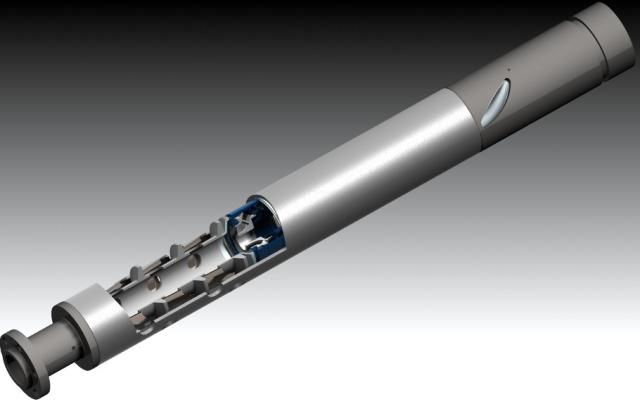
At 3.38 in., the CENtrilift PASS slimline ESP system offered by Baker Hughes can operate at fl ow rates between 50 bbl/d and 2,500 bbl/d. (Source: Baker Hughes)
Casing sizes have shrunk as unconventional wells have gone deeper. These smaller diameter wells, or those with restricted space due to casing patches or complex completion designs, can be especially perplexing when the time comes to artificially lift them. Pumps need space, and that space decreases the closer the pump gets to the reservoir.
With the release of its CENtrilift PASS slimline electric submersible pump (ESP) system, Baker Hughes added a new solution for operators looking to lower their lifting costs in these perplexing wells while optimizing production to increase reserve recovery. It is the industry’s only small-diameter ESP system capable of operating at flow rates down to 50 bbl/d, according to a company press release.
At 3.38 in., the slimline ESP system is smaller in diameter than a standard hamburger bun but larger than a baseball. Closer in diameter to a croquet ball, the system is capable of operating at flow rates as low as 50 bbl/d and as high as 2,500 bbl/d through its use of the FLEXPumpER extended- range pump. This wide-operating range mitigates the need to change out pumping systems as production rates decline, the company said.
Gas entrained in the production stream or gas slugs that break out of the reservoir are managed through the combination of natural and mechanical separation in a single design to minimize the amount of gas entering the pump, regardless of wellbore orientation.
When the ESP is deployed in a horizontal or deviated orientation, gravity cups shift to block the pump inlet ports on the high side of the intake where the gas accumulates, preventing the gas from entering the pump and venting it into the annulus, the release said.
When the ESP is installed vertically, the production stream bypasses the gravity cups, and mechanical vortex gas separation technology diverts gas away from the pump and into the annulus. For applications that only require mechanical gas separation, the CENtrilift PASS system includes a vortex gas separator. Unlike rotary gas separators, the vortex design is more efficient and far more effective at separating gas from the fluid before it can enter the pump, according to the company.
Any gas that does enter the pump is effectively handled by combining a GI gas insurance boost pump and a FLEXPumpER pump. Both pump designs are engineered to optimize performance in the presence of gas. When the two pump technologies are deployed together, the system can handle more than 60% gas volume fractions through the pump, the release said.
With a pressure rating of 5,800 psi, the ESP can be installed deeper in the well and closer to the reservoir for greater reservoir pressure drawdown and higher recovery rates. Enhancements to the motor design improve the mechanical and electrical strength of the motor by 30% while reducing the angle of the motor-to-cable connection to mitigate potential damage during installation in smaller diameter wellbores.
Recommended Reading
E&P Highlights: March 10, 2025
2025-03-10 - Here’s a roundup of the latest E&P headlines, from a new discovery by Equinor to several new technology announcements.
Tracking Frac Equipment Conditions to Prevent Failures
2024-12-23 - A novel direct drive system and remote pump monitoring capability boosts efficiencies from inside and out.
E&P Highlights: Jan. 21, 2025
2025-01-21 - Here’s a roundup of the latest E&P headlines, with Flowserve getting a contract from ADNOC and a couple of offshore oil and gas discoveries.
Formentera Joins EOG in Wildcatting South Texas’ Oily Pearsall Pay
2025-01-22 - Known in the past as a “heartbreak shale,” Formentera Partners is counting on bigger completions and longer laterals to crack the Pearsall code, Managing Partner Bryan Sheffield said. EOG Resources is also exploring the shale.
Watch for Falling Gas DUCs: E&Ps Resume Completions at $4 Gas
2025-01-23 - Drilled but uncompleted (DUC) gas wells that totaled some 500 into September 2024 have declined to just under 400, according to a J.P. Morgan Securities analysis of Enverus data.
Comments
Add new comment
This conversation is moderated according to Hart Energy community rules. Please read the rules before joining the discussion. If you’re experiencing any technical problems, please contact our customer care team.





